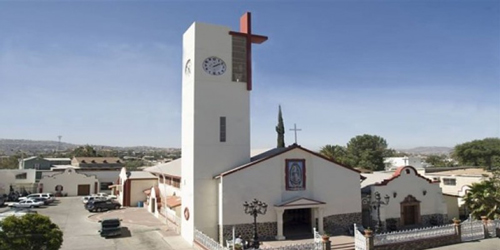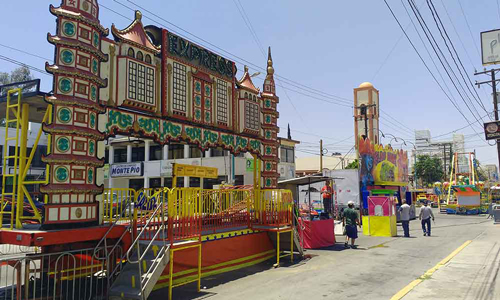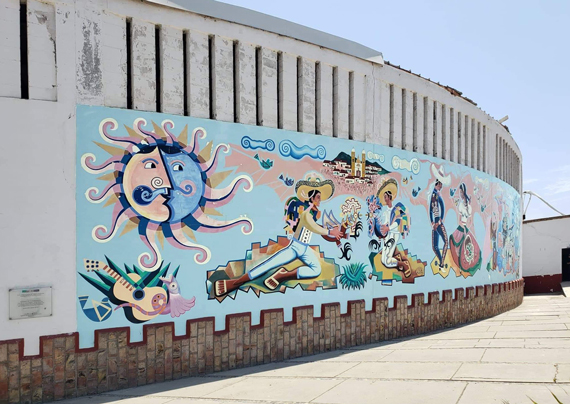|
Four Cultural Resources Newly Designated in Baja California
By Maria E Curry
September/October 2021
 Nuestra Señora de Guadalupe, Tecate's first church built in Mission style in 1941. Courtesy goapp.mx |
 The Romería de Verano annual festival, Tecate, 2017. Courtesy verazinforma.com |
 "Mexican Fiesta," 1970, mural by José María Servín Zepeda, Cortijo San José building, Playas de Tijuana. Photo by Maria E Curry |
Four cultural resources were designated in Baja California in June 2021, increasing the list to only 16 resources on the state registry. Another four resources are in the process of designation and many more are eligible. Places, traditions, and things that may be considered cultural heritage, according to the 1995 Ley del Patrimonio Cultural de Baja California (Cultural Heritage Law of Baja California), include buildings, sites, structures, objects, areas, and intangible cultural values and popular traditions, artistic expressions, and archive contents.
Newly designated is the first Catholic church in Tecate, known as Estación Misional Nuestra Señora de Guadalupe (1941). This Mission style building was erected as a result of a long community effort started in 1921 in the middle of a national religious crisis.
The second resource is an artistic, cultural, and religious tradition known as Romería de Verano, which was started in 1954 by community members, the church, and the city of Tecate. Celebrated every year, the festivities include exhibits of regional agricultural, arts and crafts, and gastronomic products. Funds raised at the event help with church repairs and social causes.
The third designation is an artistic expression: five paintings by José María Servín de Zepeda (1917-1983), an internationally recognized artist. His colorful, surreal, and mystical images focus on Mexican culture. Servín created murals in Phoenix, Arizona, and Europe, as well as Mexico.
The last resource is a collection of 95 black-and-white photos that U.S.-born Harry W. Crosby made for a tourist magazine in 1964. Located in Tijuana's municipal archive, the collection is prized for its unique view of community life in Tijuana, featuring emblematic people and places.
The 12 additional cultural resources listed with the state of Baja California are:
- Teniente Guerrero Park, the former Municipal Palace, the Álvaro Obregón ex-elementary school in Tijuana;
- Bodegas de Santo Tomás Winery district with 14 buildings, and former hotel and casino the Hotel Riviera del Pacifico in Ensenada;
- Former elementary schools: Cuauhtémoc and Presidente Alemán, and the Leona Vicario elementary school, the cemetery Pantheon of Mexicali Pioneers No. 1; and a water tank named La Bombera in Mexicali.
- Listed as manifestations of cultural interest are the zebra donkeys in Tijuana, and Baja California cuisine.
You're probably wondering why Baja California has so few designations. Unfortunately, many Mexicans are unaware of the social and economic benefits of preservation, or lack an understanding of the historic significance of architecture from the recent past. There are also overlapping legal issues in some eligible resources and a false belief that private property rights can be diminished. Only one of the designated resources is privately owned and it is successfully preserved; the rest are under state or municipal government control.
Preservation education is urgently needed for professionals, public officials, and citizens in general in order to envision a future that preserves and protects Baja California's rich heritage.
|
2025
2024
2023
2022
2021
2020
2019
2018
2017
2016
2015
|






